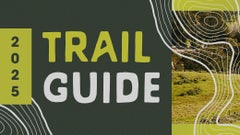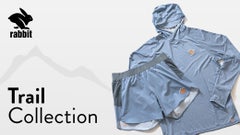Hit the Trails: A Beginner's Guide to Trail Running
Updated: December 5, 2024 by Grace Booth

Trail running is a fantastic way to escape the confines of the pavement and embrace the natural world. If you're new to trail running and eager to explore this exhilarating outdoor activity, this beginner's guide will provide you with essential information to get started, from understanding the benefits of trail running to finding local trails and even tips for navigating different terrain.
Benefits of Trail Running
Build Endurance
Improved endurance is one of the most significant benefits that trail running offers to beginners. As opposed to traditional road running, trail running involves navigating uneven terrains, steep inclines, and varying surfaces, which demands a higher level of physical exertion. By consistently pushing the limits while traversing the trails, beginners can gradually build up their aerobic capacity, allowing them to go the distance and enjoy extended running sessions with greater ease.
Improve Strength and Balance
Unlike running on a flat surface, trail running engages a broader range of muscles. Running through uneven trails and rocky terrain requires your body to stabilize and adapt, which improves overall strength and stability. As you tackle steep hills and leap over fallen logs, your lower body muscles, including the quadriceps, hamstrings, calves, and glutes, are constantly challenged. By regularly hitting the trails, you can gradually build up your strength, unlocking new levels of power and resilience that will benefit your running and enhance your everyday activities.
Boost Your Mood
Trail running not only offers physical advantages but also remarkable benefits for mental well-being. As you traverse through the winding paths, surrounded by lush greenery or breathtaking landscapes, you'll find yourself experiencing a sense of tranquility and connection with nature. The rhythmic cadence of your footsteps on the soft earth can help calm an anxious mind and promote mindfulness, allowing you to be fully present in the moment. This combination of physical exertion and the beauty of nature creates a powerful synergy that can uplift your mood, boost self-confidence, and provide a renewed sense of mental clarity and focus.

Getting Started
Find Local Trails
One of the joys of trail running is the opportunity to explore new, serene locations. There are several ways to discover these hidden gems in your area. First, check with local running clubs or outdoor organizations; they often have resources and recommendations for nearby trails. Websites and apps dedicated to trail running can also provide comprehensive lists of trails with user reviews and difficulty ratings. Other options include consulting with local park authorities and nature conservation organizations, as they may offer trail maps or guidance on where to run safely.
Progress Gradually
A gradual progression will allow your body time to adapt to uneven surfaces and changes in elevation, decreasing your chance of injury or burnout. Start with shorter, easy trails and slowly increase distance and difficulty as your endurance and strength improve. Trail running can be significantly more demanding than road running, so gradually build yourself up to running the hills and listen to your body to find a comfortable pace. You can do this by hiking the uphill climbs and running the downhills and flats.
Learn Trail Etiquette
Trail running most often involves sharing the path with hikers, mountain bikers, and other outdoor enthusiasts. Practice good trail etiquette by yielding to others, communicating politely, and respecting the environment. Leave no trace behind and follow any specific rules or regulations of the trail.
Wear the Right Footwear
Investing in a reliable pair of trail running shoes is crucial. Unlike road running shoes, trail-specific shoes are specially designed to provide better traction, stability, and protection on uneven surfaces. For a deep dive into how to choose a trail running shoe for different types of trails, from smooth trails and fire roads, to rocky and technical, to soft and muddy, check out our guide on how to choose a trail running shoe. To learn the difference between road shoes and trail shoes, read on below.
Stay Safe
Trail running introduces various elements not encountered on paved roads. Pay attention to your surroundings and be cautious while running. Carry a fully charged smartphone, and let someone know your running route and estimated return time. Running with a hydration pack with essentials like water, fuel, and a trail map or navigation device can help keep you safe while giving you peace of mind knowing you came prepared.

Choosing Trail Running Shoes and Gear
Road Shoes vs. Trail Shoes
Road running shoes, with their lightweight uppers, soft midsoles, and smooth outsole configurations, are built for high-volume repetition and protection from the hard pavement. Unfortunately, once you leave the pavement, you will quickly realize that these shoes are not designed to handle the demands of the trails. When taken offroad, these road running shoes will wear down prematurely and may not offer the support or grip your feet and joints need when tackling rough and uneven terrain.
On the other hand, trail-specific shoes provide runners with a more robust package, specifically built to withstand whatever the trails can throw at them. The uppers on trail shoes will often feature overlays that securely hold the midfoot and heel in place to help with balance on rough terrain. When it comes to the midsole design, trail shoes are usually stiffer and manufactured to provide high-level protection from uneven and rocky surfaces. Features like a flexible rock plate to protect from stone bruising and a more durable outsole with heel-to-toe rubber are also characteristics of most trail shoes. Furthermore, trail outsoles have aggressive lug configurations, allowing for better traction and durability.
Hydration Packs, Belts, and Handhelds
In addition to wearing appropriate footwear on the trails, it is equally vital to have the means to carry water and other essentials during your runs. With the loss of moisture through sweat, breathing, and energy production, it becomes crucial to prioritize hydration and prevent dehydration by ensuring you have brought enough water to replenish the fluids your body needs. One of the most popular options for carrying water during trail running is a hydration pack (also referred to as a running vest). Hydration packs keep all your essentials within arm's reach and attach securely to your body, which prevents excessive bouncing or discomfort. If you prefer a lighter option, handheld water bottles or a hydration belt with water bottle holders or insertable soft flasks can be another great alternative, allowing you to carry smaller amounts of water while being more easily accessible.
Nutrition: Gels, Chews, Drink Mixes
In order to get the most out of your runs, it is essential to fuel your body with proper nutrition. There are several options available to help keep you energized and hydrated during your workouts. Energy gels offer compact packets for quick and easy access, providing an instant energy boost, while energy chews are simply gels in chewable form, offering a different consistency. Drink mixes, available in powder form, can be mixed with water to create a hydrating and replenishing beverage, and they often contain electrolytes, which help maintain proper fluid balance and prevent dehydration. Experiment with different brands and flavors during your training to find the nutrition options that work best for you in terms of taste, digestion, and energy replenishment.

Trail Running Tips
Focus on Technique
Mastering proper trail running techniques is crucial for efficiency and injury prevention. As opposed to road running, trail running requires more focus on foot placement and balance. Keep your eyes on the trail ahead, watching for obstacles like rocks, roots, or fallen branches. Shorten your stride and maintain a slightly lower center of gravity to improve stability and reduce the risk of injury.
Distance vs. Duration
With all the variables interacting with your run—uphill, downhill, roots, rocks, creeks, loose footing, narrow single tracks—you will likely run much slower on the trail than you typically would when road running. Do not let this discourage you. Rather than focusing on pace or distance, new trail runners should focus on the overall duration of their efforts.
You never know what obstacle may be around the next turn, so managing your pace is crucial when out on trails. Settle into a pace that feels relatively comfortable and will enable you to complete the entirety of your run, which may mean walking the steeper sections of the trail or taking a break at the top. What's most important is that you find a pace that allows you to soak up the beauty of the terrain and enjoy the entire experience of your run. Before you know it, you will have racked up countless miles, ultimately resulting in the ability to run faster and further in the future.
Stay Engaged
As we mentioned earlier, there are many reasons people choose to run: freedom, physical benefits, mental clarity, and community, to name a few. What can be unique to trail running is the heightened engagement that is required. On the track or road, the scenery and motion can become relatively monotonous; however, when trail running, runners must stay mentally engaged as they maneuver through paths or avoid potential hazards. Turns, climbs, branches, creeks, and even animals can make your trail runs much more interactive than your road runs.
Ultimately one of the biggest allures of trail running is the ability to fully engage and immerse yourself in nature while disconnecting from the outside world for extended periods of time. Furthermore, the sheer sense of accomplishment when you overcome challenging terrain with nothing more than a light vest on your back and shoes on your feet is truly an exhilarating experience. Just ensure you are patient with yourself by taking the time needed to adjust to the exciting world of trail running.








